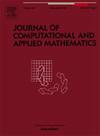基于非凸混合正则的泊松噪声消除
IF 2.6
2区 数学
Q1 MATHEMATICS, APPLIED
Journal of Computational and Applied Mathematics
Pub Date : 2024-09-19
DOI:10.1016/j.cam.2024.116289
引用次数: 0
摘要
电视正则的存在总是会引起令人不满意的阶梯效应。为了克服阶梯效应,同时更好地保留边缘信息,本研究提出了一种新的泊松噪声去除模型。该模型基于非凸混合正则,即在总变化和高阶总变化的组合中引入非凸惩罚。迭代加权 l1 算法用于将非凸模型转换为凸模型。然后采用经典的交替方向乘法来获得模型的近似解。在将该模型应用于受中高强度泊松噪声污染的退化图像时,对其噪声抑制性能进行了测试。该正则化器与其他正则化器在图像的视觉效果、时间成本以及几个公认的量化评估指标(如峰值信噪比、特征相似性指数和结构相似性指数)方面进行了比较。数值实验表明,本模型不仅能消除块状伪影,还能保留锐利的边缘。本文章由计算机程序翻译,如有差异,请以英文原文为准。
Poisson noise removal based on non-convex hybrid regularizers
The presence of TV regularizer always induces an unsatisfactory staircase effect. To overcome the staircase while better sustaining edge information, this work proposes a novel model for Poisson noise removal. The model is based on non-convex mixed regularizers, which involves introducing a non-convex penalty into a composition of the total variation and the higher-order total variation. The iterative reweighted algorithm was used to convert the non-convex model into a convex one. The classic alternating direction method of multipliers was then employed to obtain approximate solutions of the model. When applying this model to degraded images contaminated by Poisson noise of medium to high intensity, its performance in noise suppression was tested. The regularizer was compared with others in the terms of the visual effect of the picture, time cost, and several commonly accepted quantitative indicators for evaluation, such as peak signal-to-noise ratio, feature similarity index and structural similarity index. Numerical experiments showed that the present model not only eliminates block artifacts but also retains sharp edges.
求助全文
通过发布文献求助,成功后即可免费获取论文全文。
去求助
来源期刊
CiteScore
5.40
自引率
4.20%
发文量
437
审稿时长
3.0 months
期刊介绍:
The Journal of Computational and Applied Mathematics publishes original papers of high scientific value in all areas of computational and applied mathematics. The main interest of the Journal is in papers that describe and analyze new computational techniques for solving scientific or engineering problems. Also the improved analysis, including the effectiveness and applicability, of existing methods and algorithms is of importance. The computational efficiency (e.g. the convergence, stability, accuracy, ...) should be proved and illustrated by nontrivial numerical examples. Papers describing only variants of existing methods, without adding significant new computational properties are not of interest.
The audience consists of: applied mathematicians, numerical analysts, computational scientists and engineers.

 求助内容:
求助内容: 应助结果提醒方式:
应助结果提醒方式:


